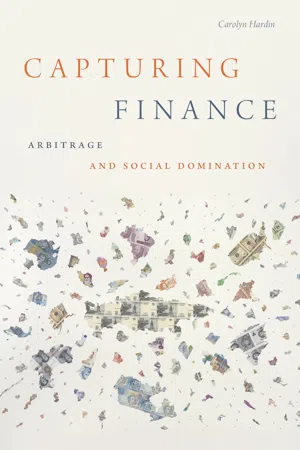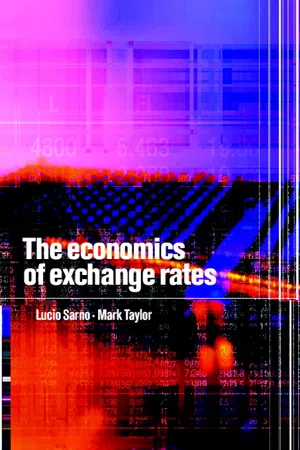Business
Law of One Price
The Law of One Price states that identical goods should have the same price in different markets when exchange rates are taken into account. This principle assumes that there are no transportation costs or trade barriers and that buyers and sellers have access to perfect information.
Written by Perlego with AI-assistance
Related key terms
1 of 5
3 Key excerpts on "Law of One Price"
- eBook - PDF
Capturing Finance
Arbitrage and Social Domination
- Carolyn Hardin(Author)
- 2021(Publication Date)
- Duke University Press Books(Publisher)
Instead, it is more like the juridical laws of nation- states in that it is a moral imperative that requires executive enforcement. Market traders are the police who carry out that enforcement. As one text-book puts it, “The Law of One Price is enforced by arbitrageurs: if they observe violation of the law, they will engage in arbitrage activity . . . until the arbitrage opportunity is eliminated,” that is, until the excess supply of the expensive asset and the excess demand for the cheap asset produced by the arbitrage trades force their prices to converge, just as Modigliani and Miller proposed (Bodie et al. 2009, 325). The arbitrage reasoning of the Law of One Price is the proof of the famed “efficient market hypothesis” published by Eugene Fama in 1970. 42 Chapter two The efficient market hypothesis states that all available information is al-ready reflected in equilibrium prices. This boils down to the point that traders act rationally on information individually, leading to an aggregate system in which all information is reflected. The mechanism by which in-formation about whether securities are the same or similar is transmuted into prices is arbitrage. According to the Law of One Price, arbitrage keeps prices in parity across markets and between similar securities, making mar-kets efficient and fair for all traders. But the notion that markets are efficient is not a neutral, scientific hy-pothesis. If markets can be made to be efficient, if they can be pushed into the idealized state of processing all available information, specific moral goods will be achieved. The entire edifice of neoliberal ideology constructed by the Mont Pelerin Society revolves around the notion that economic planning is inferior to market order because, as Friedrich von Hayek argued, the latter is by definition able coordinate the needs and resources of humans better than any “one single mind” ever could (1945, 526). - Thomas Grennes(Author)
- 2019(Publication Date)
- CRC Press(Publisher)
2 The Law of One Price: Two Levels of Aggregation Lawrence H. Officer 1. INTRODUCTION The traditional statement of the Law of One Price (WP) is that there is a unique price of a commodity or commodity basket worldwide, irrespective of the country of output or of absorption, where the respective domestic-country prices of the commodity or commodity basket are expressed in a common currency via market exchange rates. A reformulation of the law is presented below (Section 3), but the thrust of the paper is the review and coalescence of two hitherto disjoint strands of literature on the WP: studies at the aggregate [gross-domestic-product (GDP)] level and those at a disaggregate level. Interestingly, in both strands, the focus is less on the WP itself than on the theoretical explanation and empirical testing of deviations from the WP. There, however, the similarity ends; and conjunction of the approaches never begins. The present study, in contrast, after exploring the reasons for divergences from the WP at the disaggregate level, uses this analysis for econometric explanation of deviations from the LOP at the GDP level. Further, a uniform data set is used to investigate the WP at both levels of aggregation. In Section 2 concepts of the price level--crucial in formulating and testing the LOP--are defined, with special attention paid to the underlying index-number measure, neglected in both branches of the literature. In Section 3 the WP is formulated in terms of these price-level concepts and classified using a threefold schemata. The LOP at the disaggregate level is treated in Section 4 and at the GDP level in Section 5. In both sections existing approaches to testing the WP are reviewed and their weaknesses discerned, enabling development of new techniques of investigating the law while avoiding these limitations. The techniques are applied to a commonly based data set in Sections 4 and 5.- eBook - PDF
- Lucio Sarno, Mark P. Taylor(Authors)
- 2003(Publication Date)
- Cambridge University Press(Publisher)
3 3.1 PPP, the Law of One Price and price indices The Law of One Price is the fundamental building-block of the PPP condition. Formally, the LOOP in its absolute version may be written as: P i , t = S t P ∗ i , t i = 1 , 2 , . . . , N (3.1) where P i , t denotes the price of good i in terms of the domestic currency at time t , P ∗ i , t is the price of good i in terms of the foreign currency at time t , and S t is the nominal exchange rate expressed as the domestic price of the foreign currency at time t . According to equation (3.1), the absolute version of the LOOP essentially postulates that the same good should have the same price across countries if prices are expressed in terms of the same currency of denomination. The basic argument why the LOOP should hold is generally based on the idea of frictionless goods arbitrage. In its relative version, the LOOP postulates the relatively weaker condition: P ∗ i , t + 1 S t + 1 P i , t + 1 = P ∗ i , t S t P i , t i = 1 , 2 , . . . , N . (3.2) Obviously, the absolute LOOP implies the relative LOOP, but not vice versa. Clearly, the LOOP can be adequately tested only if goods produced internationally are perfect substitutes. If this is the case, then the condition of no profitable arbitrage should ensure equality of prices in highly integrated goods markets. Nevertheless, the presence of any sort of tariffs, transport costs and other non-tariff barriers and duties would induce a violation of the no-arbitrage condition and, inevitably, of the LOOP. Also, the assumption of perfect substitutability between goods across different countries is crucial for verifying the LOOP. In general, however, product differentiation across countries creates a wedge between domestic and foreign prices of a product which is proportional to the freedom with which the good itself can be traded.
Index pages curate the most relevant extracts from our library of academic textbooks. They’ve been created using an in-house natural language model (NLM), each adding context and meaning to key research topics.


